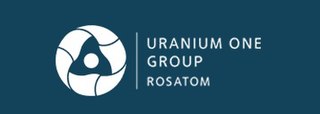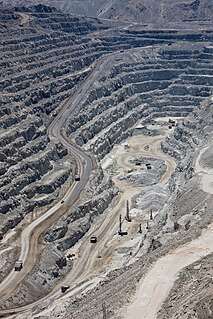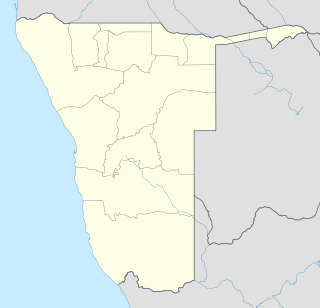Eldorado Gold Corporation is a Canadian company that owns and operates gold mines in Turkey, Greece and Canada. Since its merger with European Goldfields in 2011 the company has been pursuing the development of the Skouries mine, Olympias mine and Stratoni mine in Greece. The company previously developed and operated gold mines in China, Brazil and Mexico. Headquartered in Vancouver and listed on the Toronto and New York Stock Exchanges, Eldorado Gold has developed and operated assets from several merged companies HRC Developments Corporation, Afcan Mining Corporation, Sino Gold Mining, Brazauro Resources, Integra Gold, as well as European Goldfields.

Cameco Corporation is the world's largest publicly traded uranium company, based in Saskatoon, Saskatchewan, Canada. In 2015, it was the world's second largest uranium producer, accounting for 18% of world production.

The uranium market, like all commodity markets, has a history of volatility, moving with the standard forces of supply and demand as well as geopolitical pressures. It has also evolved particularities of its own in response to the unique nature and use of uranium.
Sherritt International is a Canadian resource company, based in Toronto, Ontario. Sherritt is a world leader in the mining and refining of nickel and cobalt – metals essential for the growing adoption of electric vehicles. Its Technologies Group creates innovative, proprietary solutions for oil and mining companies around the world to improve environmental performance and increase economic value. Sherritt is also the largest independent energy producer in Cuba. Sherritt’s common shares are listed on the Toronto Stock Exchange under the symbol “S”.

The Rössing Uranium Mine in Namibia is the longest-running and one of the largest open pit uranium mines in the world. It is located in the Namib Desert near the town of Arandis, 70 kilometres from the coastal town of Swakopmund. Discovered in 1928, the Rössing mine started operations in 1976. In 2005, it produced 3,711 tonnes of uranium oxide, becoming the fifth-largest uranium mine with 8 per cent of global output. Namibia is the world's fourth-largest exporter of uranium.
Kinross Gold Corporation is a Canadian-based gold and silver mining company founded in 1993 and headquartered in Toronto, Ontario, Canada. Kinross currently operates seven active gold mines, and was ranked fifth of the "10 Top Gold-mining Companies" of 2019 by InvestingNews. The company's mines are located in Brazil, Ghana, Mauritania, Russia and the United States. It trades under the KGC ticker in the New York Stock Exchange, and under K in the Toronto Stock Exchange.

Denison Mines Corp. is a Canadian uranium exploration, development, and production company. Founded by Stephen B. Roman, and best known for its uranium mining in Blind River and Elliot Lake, it later diversified into coal, potash, and other projects.

Mining in Iran is still under development, yet the country is one of the most important mineral producers in the world, ranked among 15 major mineral-rich countries, holding some 68 types of minerals, 37 billion tonnes of proven reserves and more than 57 billion tonnes of potential reserves worth $770 billion in 2014. Mineral production contributes only 0.6 per cent to the country's GDP. Add other mining-related industries and this figure increases to just four per cent (2005). Many factors have contributed to this, namely lack of suitable infrastructure, legal barriers, exploration difficulties, and government control.
Paladin Energy Ltd is a Western Australian based uranium production company.

Nuclear power is the fifth-largest source of electricity in India after coal, gas, hydroelectricity and wind power. As of November 2020, India has 23 nuclear reactors in operation in 7 nuclear power plants, with a total installed capacity of 7,480 MW. Nuclear power produced a total of 43 TWh in 2020-21, contributing 3.11% of total power generation in India. 10 more reactors are under construction with a combined generation capacity of 8,000 MW.

Uranium One Inc. is a Canadian uranium mining company with headquarters in Toronto, Ontario. Since 2013, it is a wholly owned subsidiary of Moscow-based Uranium One Group, a part of the Russian state-owned nuclear corporation Rosatom.

Mining is the biggest contributor to Namibia's economy in terms of revenue. It accounts for 25% of the country's income. Its contribution to the gross domestic product is also very important and makes it one of the largest economic sectors of the country. Namibia produces diamonds, uranium, copper, magnesium, zinc, silver, gold, lead, semi-precious stones and industrial minerals. The majority of revenue comes from diamond mining. In 2014, Namibia was the fourth-largest exporter of non-fuel minerals in Africa.
Uranium production is an important part of the African economy, with Niger, Namibia, Libya and South Africa creating up to 18% of the world's annual production. Many African countries produce uranium or have untapped uranium ore deposits.

ARMZ Uranium Holding Co. is a Russian uranium mining company. It is wholly owned by Atomenergoprom, a part of Rosatom.
Sandstorm Gold Ltd. is a Canadian company that provides funding to mining companies in exchange for royalties, principally in the form of net smelter returns and streams. The company focuses on precious metals but did spin off Sandstorm Metals & Energy Ltd. in 2010 as a separate TSX Venture Exchange-listed company to make volumetric production payment transactions in the base metal and fossil fuel sectors, then bought it back in 2014. Sandstorm Gold graduated from the TSX Venture Exchange to the Toronto Stock Exchange and began listing shares on the New York Stock Exchange in 2012.

Uranium mining in Namibia is of considerable importance to the national economy. In 2018, Namibia produced 10% of uranium worldwide, ranked as the 4th largest producer, behind Kazakhstan, Canada, and Australia.
The world's largest producer of uranium is Kazakhstan, which in 2019 produced 43% of the world's mining output. Canada was the next largest producer with a 13% share, followed by Australia with 12%. Uranium has been mined in every continent except Antarctica.

The Norasa uranium project comprises the Valencia and Namibplaas deposits in Erongo Region in the western part of Namibia. The two parts are 7 kilometres (4.3 mi) apart and both are fully owned by Forsys Metals. It represents one of the largest uranium resources in Namibia, having an estimated resource of 48,200 tU in ore grading 0.014-0.0167% uranium. The Valencia deposit was named after the farm where the uranium deposits were found.

The Husab Mine, also known as the Husab Uranium Project, is a uranium mine near the town of Swakopmund in the Erongo region of western-central Namibia. The mine is located approximately 60 kilometres (37 mi) from Walvis Bay. The Husab Mine is expected to be the second largest uranium mine in the world after the McArthur River uranium mine in northern Saskatchewan, Canada and the largest open-pit mine on the African continent. Mine construction started in 2014. The Husab Mine started production towards the end of 2016 after completion of the sulfuric acid leaching plant.
Orano SA is a multinational nuclear fuel cycle company headquartered in Châtillon, Hauts-de-Seine, France. The company is engaged in uranium mining, conversion-enrichment, spent fuel recycling, nuclear logistics, dismantling, and nuclear cycle engineering activities. It was created in 2017 as a result of restructuring and recapitalizing of the nuclear conglomerate Areva. Orano is majority owned by the French state.











